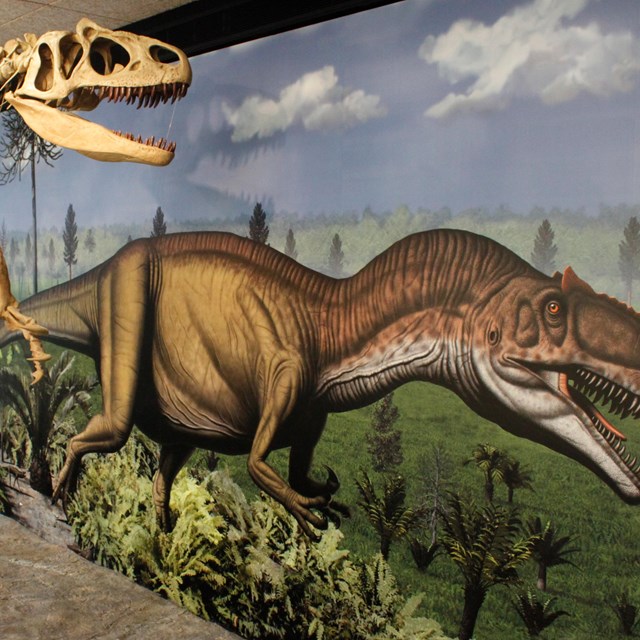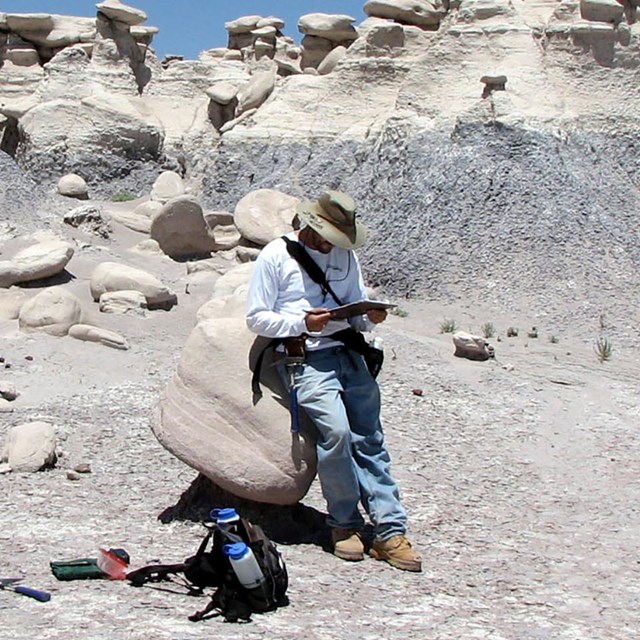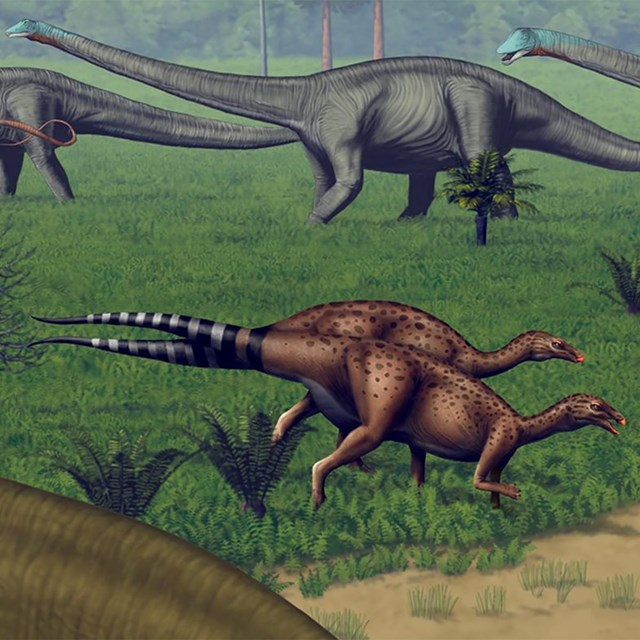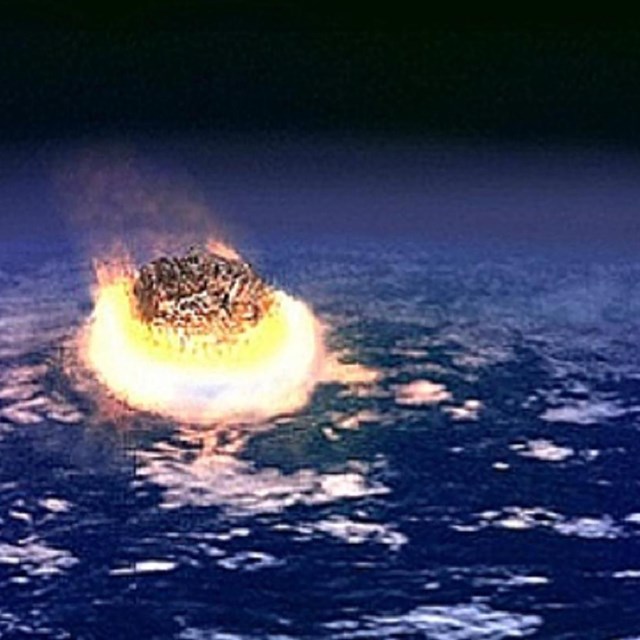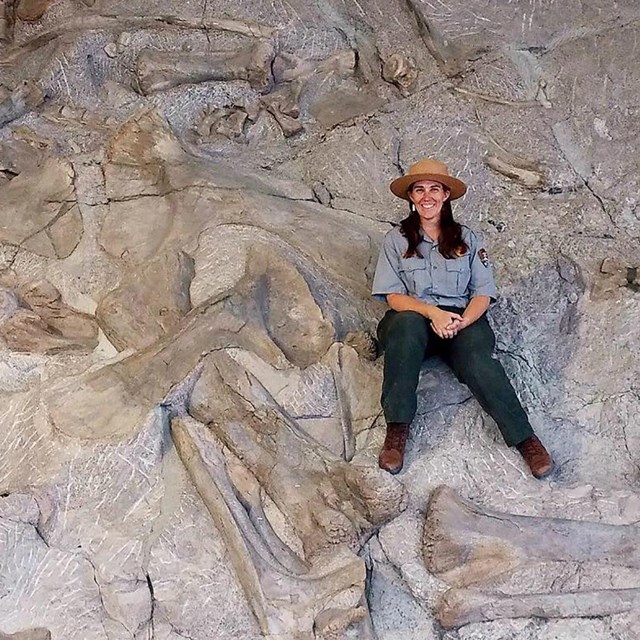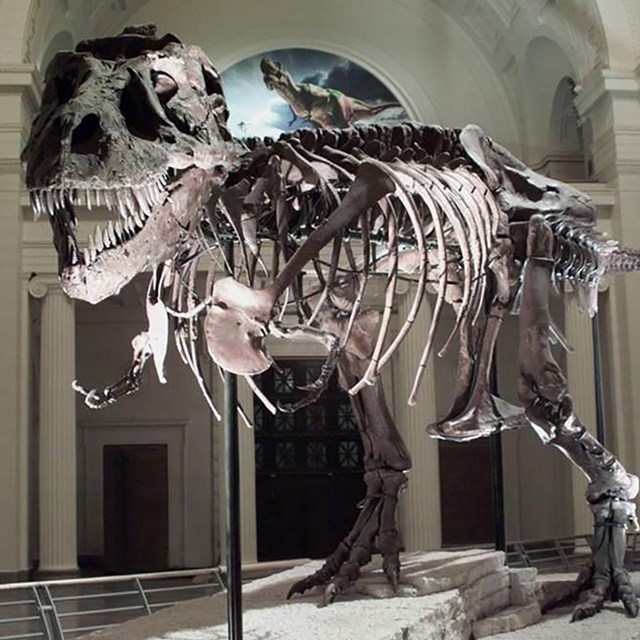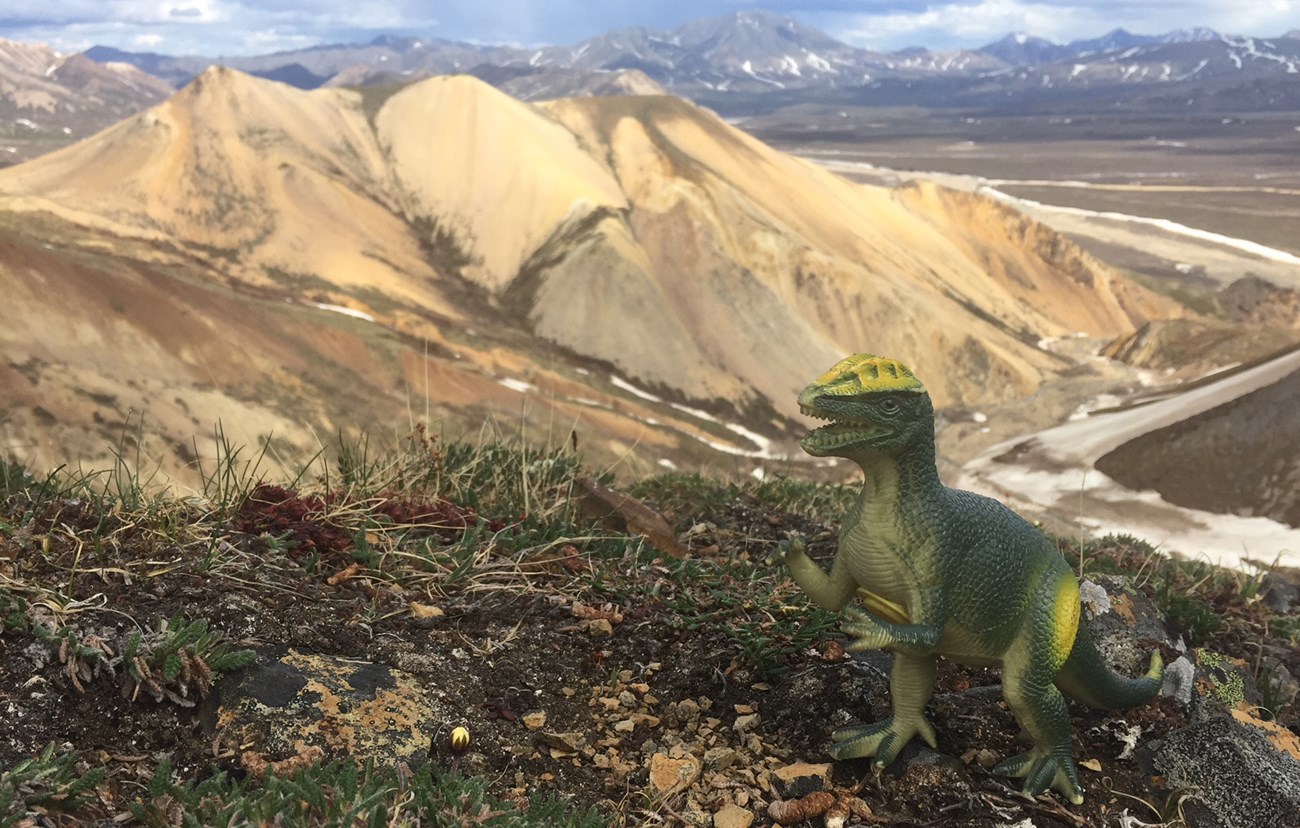
NPS photo by participants in Denali Backcountry Adventure, a camp for young adults (2018).
Introduction
Dinosaurs are among the most popular and iconic fossil organisms, and dinosaur bones and tracks are favorite attractions at several National Park Service units. Body and trace fossils of non-avian dinosaurs have been documented from at least 21 NPS areas. Geographically, this record spans across the continental United States, from Big Bend National Park (Texas) to Springfield Armory National Historic Site (Massachusetts), and north to Denali National Park and Preserve (Alaska), but is centered on the Colorado Plateau.
Getting to know Dinosaurs
Dinosaurs through Geologic Time
All dinosaurs (aside from birds) lived and died in the Mesozoic Era. The Mesozoic (252 to 66 million years ago) was the "Age of Reptiles." Dinosaurs, crocodiles, and pterosaurs ruled the land and air. As climate changed, sea levels rose world-wide and seas expanded across the center of North America. Large marine reptiles such as plesiosaurs, along with the coiled-shell ammonites, flourished in these seas. Common Mesozoic fossils include dinosaur bones and teeth, and diverse plant fossils.
The Mesozoic Era is further divided into three Periods: the Triassic, the Jurassic, and the Cretaceous.
Park fossils document dinosaurs from the Late Triassic (approximately 210 million years ago) to the end of the Cretaceous (66 million years ago). This encompasses everything from some of the earliest known dinosaurs of North America, to desert trackmakers of Early and Middle Jurassic age, to giant sauropods and plate-backed stegosaurs of the Late Jurassic, to new discoveries from the Early Cretaceous through the early Late Cretaceous , to tyrannosaurs and titanosaurs at the end of the Cretaceous.
-
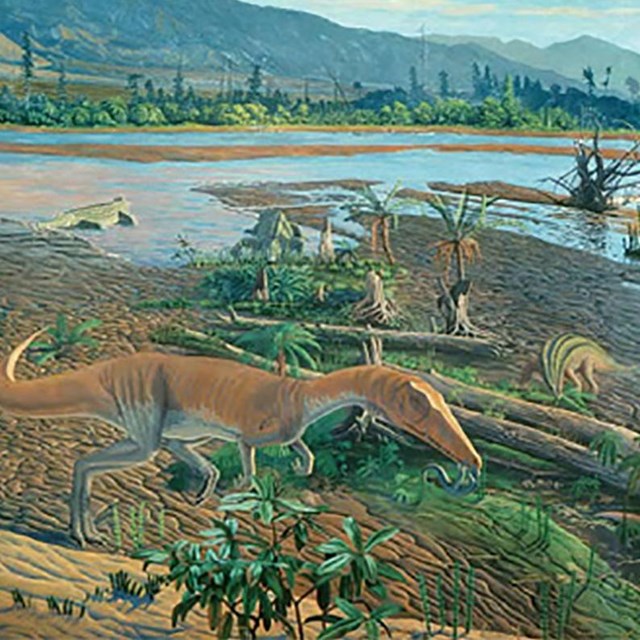 Triassic Dinosaurs
Triassic Dinosaurs251.9 to 201.3 Million Years Ago
-
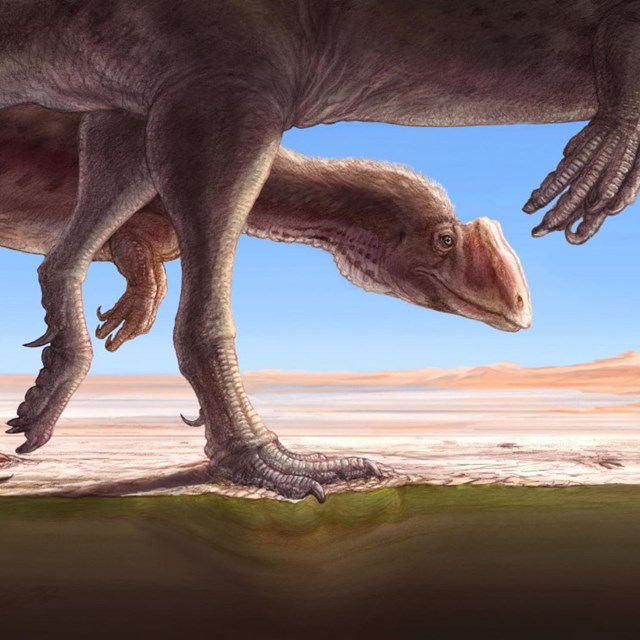 Jurassic Dinosaurs
Jurassic Dinosaurs201.3 to 145.0 Million Years Ago
-
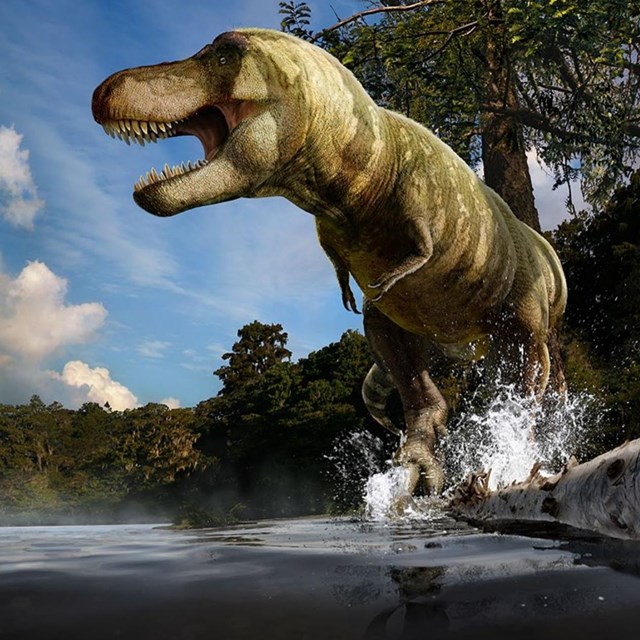 Cretaceous Dinosaurs
Cretaceous Dinosaurs145.0 to 66.0 Million Years Ago
Dinosaur Discoveries
The first report of dinosaurs associated with places that would one day be protected in the National Park Service goes back to the Lewis and Clark expedition. On July 25, 1806 near Pompey’s Pillar in Montana, William Clark found a large fossil bone that was likely from a dinosaur. This was along what is now commemorated in Lewis & Clark National Historic Trail. The study of dinosaurs in North America began in earnest in the 1850s, and one of the first specimens to include more than a bone or two was recovered from Springfield Armory in 1855. This specimen was described as a small herbivore, Megadactylus polyzelus (renamed Anchisaurus). Probably the most significant event for the study of dinosaurs in NPS areas was Earl Douglass’s discovery of what would become the Dinosaur Quarry on August 17, 1909, eventually leading to Dinosaur National Monument (Utah/Colorado) and the famous quarry wall display. To the south, expeditions to collect dinosaur fossils in the future Big Bend National Park (Texas) began in the 1930s.
Dinosaur-related scientific work has been increasing in the NPS since the late 1970s. For example, over that time span there have been significant footprint finds in Alaska and the Colorado Plateau. Also, 14 of the 19 dinosaur species named from fossils found in or associated with NPS areas have been named since 1988.
Non-Avian Dinosaurs Named from Fossils Collected in Parks
| Species | Park | Citation | Age | Formation | Specimen | Notes |
|---|
ACM: Beneski Museum of Natural History, Amherst College
BIBE: Big Bend National Park
CM: Carnegie Museum of Natural History
DINO: Dinosaur National Monument
LSUMGS: Louisiana State University Museum of Geoscience
LSUMNS: Louisiana State Museum of Natural Sciences
OLSP: Old Spanish National Historic Trail
PEFO: Petrified Forest National Park
SPAR: Springfield Armory National Historic Site
TMM: Texas Memorial Museum
USNM: National Museum of Natural History
UTEP: Centennial Museum and Chihuahuan Desert Gardens, University of Texas-El Paso
-
Carpenter, K. and Y. Wilson. 2008. A new species of Camptosaurus (Ornithopoda, Dinosauria) from the Morrison Formation (Upper Jurassic) of Dinosaur National Monument, Utah, and a biomechanical analysis of its forelimb. Annals of Carnegie Museum 76(4):227–263.
-
Carpenter, K., and P. M. Galton. 2018. A photo documentation of bipedal ornithischian dinosaurs from the Upper Jurassic Morrison Formation, USA. Geology of the Intermountain West 5:167–207.
-
Chure, D. J. 1994. Koparion douglassi, a new dinosaur from the Morrison Formation (Upper Jurassic) of Dinosaur National Monument: the oldest troodontid (Theropoda: Maniraptora). Geology Studies 40:11–15.
-
Chure, D. J., and M. A. Loewen. 2020. Cranial anatomy of Allosaurus jimmadseni, a new species from the lower part of the Morrison Formation (Upper Jurassic) of western North America. PeerJ 8:e7803.
-
Chure, D., B. Britt, J. A. Whitlock, and J. A. Wilson. 2010. First complete sauropod dinosaur skull from the Cretaceous of the Americas and the evolution of sauropod dentition. Naturwissenschaften 97(4):379–391.
-
Cope, E. D. 1877. On a dinosaurian from the Trias of Utah. Proceedings of the American Philosophical Society 16:579–584.
-
Ellinger, T. U. H. 1950. Camarasaurus annae – a new American sauropod dinosaur. The American Naturalist 84:225–228.
-
Hitchcock, E. 1865. Supplement to the ichnology of New England. Wright and Potter, Boston, Massachusetts, USA.
-
Holland, W. J. 1915. A new species of Apatosaurus. Annals of the Carnegie Museum 10:143–145.
-
Holland, W. J. 1919. Section V. Paleontology. Carnegie Institute, Annual Reports 1918–1919:167–169.
-
International Commission on Zoological Nomenclature (ICZN). 2015. Opinion 2361 (Case 3561): Anchisaurus Marsh, 1885 (Dinosauria, Sauropodomorpha): usage conserved by designation of a neotype for its type species Megadactylus polyzelus Hitchcock, 1865. Bulletin of Zoological Nomenclature 72(2):176–177.
-
Lehman, T. M. 1989. Chasmosaurus mariscalensis, sp. nov., a new ceratopsian dinosaur from Texas. Journal of Vertebrate Paleontology 9(2):137–162.
-
Lehman, T. M., S. L. Wick, and J. R. Wagner. 2016. Hadrosaurian dinosaurs from the Maastrichtian Javelina Formation, Big Bend National Park, Texas. Journal of Paleontology 90(2):333–356.
-
Lehman, T. M., S. L. Wick, and K. R. Barnes. 2017. New specimens of horned dinosaurs from the Aguja Formation of West Texas, and a revision of Agujaceratops. Journal of Systematic Palaeontology 15(8):641–674.
-
Long, R. A. and P. A. Murry. 1995. Late Triassic (Carnian and Norian) tetrapods from the southwestern United States. New Mexico Museum of Natural History and Science, Albuquerque, New Mexico. Bulletin 4.
-
Longrich, N. R., J. Sankey, and D. Tanke. 2010. Texacephale langstoni, a new genus of pachycephalosaurid (Dinosauria: Ornithischia) from the upper Campanian Aguja Formation, southern Texas, USA. Cretaceous Research 31:274–284.
-
Prieto-Márquez, A., J. R. Wagner, and T. Lehman. 2020. An unusual "shovel-billed" dinosaur with trophic specializations from the early Campanian of Trans-Pecos Texas, and the ancestral hadrosaurian crest. Journal of Systematic Palaeontology 18(6):461–498.
-
Sankey, J. T. 2001. Late Campanian southern dinosaurs, Aguja Formation, Big Bend, Texas. Journal of Paleontology 75(1):208–215.
-
Wagner, J. R. and T. M. Lehman. 2009. An enigmatic new lambeosaurine hadrosaur (Reptilia: Dinosauria) from the Upper Shale Member of the Campanian Aguja Formation of Trans-Pecos Texas. Journal of Vertebrate Paleontology 29(2):605–611.
-
Wick, S. L. and T. M. Lehman. 2013. A new ceratopsian dinosaur from the Javelina Formation (Maastrichtian) of West Texas and implications for chasmosaurine phylogeny. Naturwissenschaften 100(7):667–682.
-
Also see, NPS—Geologic Time Scale
Featured Articles
Educator Resources
Site Index and Credits
Age of Dinosaurs (2021)
Text by Justin Tweet (AGI). Contributors: Vincent Santucci (GRD), Adam Marsh (PEFO), ReBecca Hunt-Foster (DINO), Don Corrick (BIBE). Project Lead / Web Development, Jim Wood (GRD).
References
-
Tweet, J.S. and V.L. Santucci. 2018. An Inventory of Non-Avian Dinosaurs from National Park Service Areas. in Lucas, S.G. and Sullivan, R.M., (eds.), Fossil Record 6. New Mexico Museum of Natural History and Science Bulletin 79: 703-730. https://irma.nps.gov/DataStore/Reference/Profile/2257153
-
Santucci, V.L., A. Marsh, W. Parker, D. Chure, and D. Corrick, 2018. “Age of Reptiles”: Uncovering the Mesozoic Fossil Record in three Intermountain national parks. IMR Crossroads. Spring 2018, p. 4-11. https://irma.nps.gov/DataStore/Reference/Profile/2253529
Last updated: April 5, 2023

